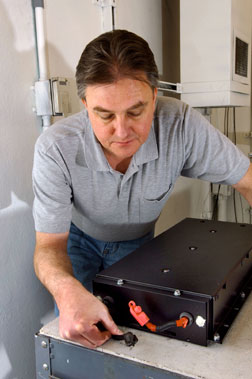NEWS RELEASES
FOR IMMEDIATE RELEASE
January 16, 2006
Sandia researchers seek ways to make lithium-ion batteries work longer, safer
Batteries could soon replace standard nickel-metal hydride batteries in hybrid vehicles
 POWER TO THE PEOPLE — Sandia researcher Brad
Hance examines a lithium-ion battery that may someday be
put in a hybrid car. (Photo by Randy Montoya)
POWER TO THE PEOPLE — Sandia researcher Brad
Hance examines a lithium-ion battery that may someday be
put in a hybrid car. (Photo by Randy Montoya)Download 300dpi JPEG image, “brad-hance.jpg,” 770K (Media are welcome to download/publish this image with related news stories.)
ALBUQUERQUE, N.M. — As part of the Department of Energy-funded FreedomCAR program, Sandia National Laboratories’ Power Sources Technology Group is researching ways to make lithium-ion batteries work longer and safer. The research could lead to these batteries being used in new hybrid electric vehicles (HEVs) in the next five to ten years.
“Batteries are a necessary part of hybrid electric-gasoline powered vehicles and someday, when the technology matures, will be part of hybrid electric-hydrogen fuel cell powered vehicles,” says Dan Doughty, manager of Sandia’s Advanced Power Sources Research and Development Department. “Current hybrid vehicles use nickel-metal hydride batteries, but a safe lithium-ion battery will be a much better option for the hybrids.”
He notes a lithium-ion battery has four times the energy density of lead-acid batteries and two to three times the energy density of nickel-cadmium and nickel-metal hydride batteries. It also has the potential to be one of the lowest-cost battery systems.
Doughty’s department receives about $1.5 million a year from the FreedomCAR program to improve the safety, lengthen the lifetime, and reduce costs of lithium-ion batteries.
Sandia is a National Nuclear Security Administration lab.
The FreedomCAR program, initiated by President Bush in 2002, focuses on developing hydrogen-powered electric vehicles to help free the U.S. from dependence on foreign oil supplies. Five national laboratories — Sandia, Argonne, Lawrence Berkeley, Idaho, and Brookhaven — are involved in the program, each researching different aspects of making hybrid electric-hydrogen vehicles a reality.
Sandia’s FreedomCAR work centers on the areas of battery abuse tolerance and accelerated lifetime prediction, with abuse tolerance receiving most of the focus.
“We want to develop a battery that has a graceful failure — meaning that if it’s damaged, it won’t cause other problems,” Doughty says. “We have to understand how batteries fail and why they fail.”
The technical goal is to comprehend mechanisms that lead to poor abuse tolerance, including heat- and gas-generating reactions. Understanding the chemical response to abuse can point the way to better battery materials. But, Doughty says, there is no “magic bullet” for completely stable lithium-ion cells.
“Fixing the problem will come from informed choices on improved cell materials, additives, and cell design, as well as good engineering practices.”
Work in abuse tolerance is beginning to shed light on mechanisms that control cell response, including effects of the anode and cathode, electrolyte breakdown, and battery additives.
The other area of work, accelerated life test, involves developing a method to predict lithium-ion battery life.
“We have two approaches in our research — the empirical model and the mechanistic model,” Doughty says. “The empirical model generates life prediction from accelerated degradation test data, while the mechanistic model relates life prediction to changes in battery materials. Our approach provides an independent measure of battery life so we don’t have to rely on what battery manufacturers tell us.”
Improved abuse test procedures developed at Sandia have led to lithium-ion test standards that the battery team has developed and recently published in a Sandia research report. Doughty anticipates that the Society of Automotive Engineers will soon adopt these test procedures as national standards, just as they adopted in 1999 the abuse test procedures Sandia developed for electric vehicle batteries.
“There has been substantial progress in making batteries more tolerant to abusive conditions,” Doughty says. “It won’t be long before these batteries will be used in gasoline-electric hybrid vehicles. And the great thing is this technology will be able to transfer over to the electric-hydrogen fuel cell powered hybrid vehicles of the future.”
Sandia is a multiprogram laboratory operated by Sandia Corporation, a Lockheed Martin company, for the U.S. Department of Energy’s National Nuclear Security Administration. Sandia has major R&D responsibilities in national security, energy and environmental technologies, and economic competitiveness.
Sandia Media Contact: Chris Burroughs, coburro@sandia.gov, (505) 844-0948
Sandia Technical Contact: Dan Doughty, dhdough@sandia.gov, (505) 845-8105